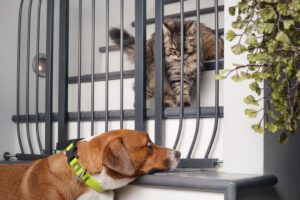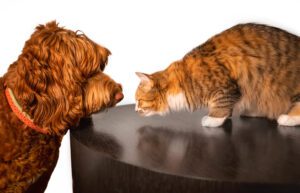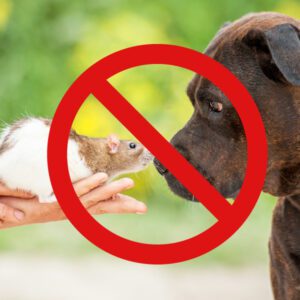“Are you a cat person or a dog person?” For 24% of the US population, the answer is both! Owning both cats and dogs can give you the best of both worlds, but getting these two opposites to get along is a challenge all of it’s own. We are here to tell you that peace is possible! Here is how to introduce your puppy to your cat.

Consider Personalities
Before embarking on this endeavor, you should carefully consider if you believe your pets will be compatible with each other.
It can be difficult to tell if a cat will adjust to living with a dog. Ideally, if the cat has tolerated dogs in the past, this is a good indication that they can coexist with your new puppy. If your cat has never been exposed to a dog, consider their personality. Is your cat very anxious or prone to lashing out? Does your cat have chronic pain such as arthritis that may be triggered by a rambunctious puppy? Does your cat growl when they see dogs through a window? All of these are signs that that your cat may not appreciate a canine as a part of the family. A confident cat that not inclined to use its claws as its first line of problem-solving would be best suited to living with a dog.
Dogs’ personalities are shaped through a combination of their breed and experiences. Non-herding dogs that have a low prey drive are the most likely to live happily with a kitty companion. Any of the dogs that appear on our list of Ten Amazing Dog Breeds for Kids would be a good candidate for a multi-species household. High drive breeds, such as Huskies, Malamutes, or those in the terrier family could be a threat to the cat’s safety. Herding dogs, such as Australian Shepherds, German Shepherds, or Corgis may try to corral the cat, which most cats will not appreciate.

As always, while breed informs part of a dog’s personality, their experiences also affect them significantly. Introducing a cat to a dog while it is still within its first few formative months is most likely to result in a peaceful coexistence – maybe even a friendship, depending on the animals! Just remember that both factor will play a role in your puppy’s personality and choose your breed accordingly. All the training in the world may not be enough to convince certain Huskies that a cat is not an afternoon snack.
Body Language, body language, body language!
Unlike introducing two dogs, cats and dogs have an added challenge of a “language barrier”! These two species can come to understand and respect one another, but this knowledge will not come to them instinctively. It is important for their owner to be familiar with both dog body language and cat body language. Cats also have much less expressive faces than dogs, which means that their body language is especially vital. You can read more about cat body language here, but here is a quick crash course in cat body language:
Green Flags

- Ears pointed forward
- Tail pointing up
- Relaxed whiskers
- Standing or sitting normally
- Laying on their side or back
Yellow Flags

- Ears turned to the side (“airplane ears”)
- Tail wrapped around themselves or held close to the body
- Tail flicking or thumping
- Meowing
- Widened eyes
- Whiskers pulled back
- Body curled to make themselves small
Red Flags

- Ears pinned back
- Tail curled under their belly or lashing from side to side
- Fur on end
- Back arched
- Aggressive vocalizations (growling, yowling, and hissing)
In short, if your cat looks like a Halloween decoration, they’re not a happy camper.
Home Sweet Home
Both cats and dogs are instinctively territorial. While a dog-dog introduction is best done in neutral territory, removing a cat from their home territory will make them feel vulnerable, diminishing the chances of a positive interaction to virtually nil. Instead, a gradual introduction within the home is the way to go. This does mean that the process will go slowly, but for a happy family, it is worth the wait!
The Nose Knows
When you first bring your puppy home, do not introduce the two right away. In fact, for the first few days, they should not even lay eyes on each other! Create a “home base” for your puppy for these first few days in an area that can be closed off from your cat by a door.

Both cats and dogs have acute senses of smell and hearing. Even if they cannot see one another, they definitely know that there is another animal around! You can also place a blanket where your puppy and cat sleep and swap the blankets periodically to exchange scents. (Note: Do NOT attempt this if your puppy it prone to tearing things up and eating them.) At meal times, feed your cat and your puppy near to the closed door. A slow introduction allows your pets to adjust slowly and build positive association with one another.
First Looks
When both your cat and your puppy can eat beside the door in a relaxed manner, and your cat is using the litterbox, eating and drinking normally, and not hiding constantly you can move onto step 2 – allowing for first looks. Separate your pets with a gate or place the puppy in an x-pen. Keep in mind that cats can jump and fit through narrow spaces, so be certain to select a barrier that your cat cannot squeeze through and watch out for signs that they’re about to jump. Allow your cat and puppy to investigate one another. Have treats on hand for each of them.
Offer treats to the cat when it is near the dog, even if it may take some time for your cat to be willing to approach the barrier. Do not reward aggressive or fearful behavior. Reward the puppy when it is paying attention to you or behaving calmly toward the cat. It is acceptable if the puppy is curious about the cat, but it should not be trying obsessively to get to it. If your dog stiffens or becomes fixated on the cat, this is an indication that their prey drive is kicking in. Redirect your puppy with a toy. You cat should always, always have an exit from the situation, and they should always be allowed to leave.

Do NOT engage in any sort of punishment with either animal. Your objective is to create a positive association. Moreover, empirical evidence supports that cats do not understand punishment in the same way people or dogs do. Rather than teach them not to do the undesired action, you’re more likely to make your cat resent you and possibly the puppy as well. If you are struggling getting your puppy to stop trying to get at your cat, consulting a professional trainer may be in order.
Keep an eye on body language for both parties. If you are observing signs of stress, stop and allow them to calm down before trying the introduction again. Keep sessions short at first and lengthen them as your puppy and cat become more accustomed to one another. If at all possible, try to end each session on a positive note. You will know that you are ready to move on from this step when both the puppy and the cat can calmly exist on either side of the barrier.
Face to Face
Having tackled introductions with a barrier, your next step will be introductions in the same room. Ideally, tackle this step with another person to help you so that you can each focus your attention on one animal and be their advocate. Keep your dog securely leashed at all times. Your cat should still be allowed to leave the situation. Be sure to provide vertical escape routes (such as a cat tree) to help your cat feel secure.

The rules of engagement for this as the previous step. Reward the cat intermittently for being in the same room as the dog. Consider playing with your cat during this session to further boost the positive experience and to persuade them to stay in the area. Reward your puppy for calm behavior. If you observe signs of stress or aggression, go back to the previous step until both pets can relax again. If both animals seem to be calm and adjusting well, you can release the leash, but be prepared to step on or grab it if your puppy starts chasing your cat.
One Big Happy Family!

If you’ve reached this step – congratulations! You are well on your way to having a multi-species home. One final word of caution – if you are not available to supervise, your puppy and your cat should be in separate, secure areas. Only allow them to be unattended when you are absolutely certain that they are safe around each other (one month or more positive, peaceful interactions). In the short term, mutually ignoring each other and behavior normally is a great place to start! Your two furry friends will have lots of time to build a friendship.
What About Other Small Animals?
 You’ve probably seen them before – videos of a dog and a hamster or other small animal that are “best friends” – and we agree, they’re absolutely adorable! However, when it comes to small animals other than cats, the risk that you take in introducing your dog to them harshly outweighs the benefits. All dogs are descended from wolves, which means that they have some measure of natural prey drive. The last thing that anyone would want is for your beloved pet to end up on the wrong side of this instinct. It is possible to find other guides on introducing small animals to dogs, but we will simply say this: we urge you to keep all small pets in secure enclosures that are out of reach of your puppy, and never allow your puppy to interact with these small animals directly.
You’ve probably seen them before – videos of a dog and a hamster or other small animal that are “best friends” – and we agree, they’re absolutely adorable! However, when it comes to small animals other than cats, the risk that you take in introducing your dog to them harshly outweighs the benefits. All dogs are descended from wolves, which means that they have some measure of natural prey drive. The last thing that anyone would want is for your beloved pet to end up on the wrong side of this instinct. It is possible to find other guides on introducing small animals to dogs, but we will simply say this: we urge you to keep all small pets in secure enclosures that are out of reach of your puppy, and never allow your puppy to interact with these small animals directly.



